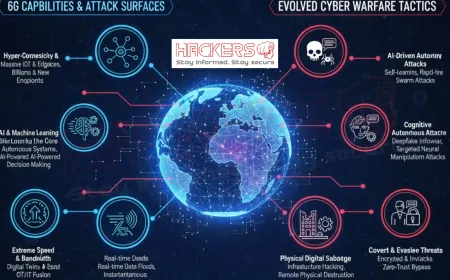What Makes IPv6 Networks Harder Yet Risky to Secure?
Every device you use: your phone, laptop, smart fridge, car, and even your light bulbs, needs an address to talk on the internet. That address is called an IP address. For decades, we used IPv4, a system with about 4.3 billion possible addresses. We ran out. Now, the world is switching to IPv6, a newer system with so many addresses that every grain of sand on Earth could have its own. This should be a security win. After all, more space means less sharing, fewer tricks, and better tracking. Right? Not quite. IPv6 is not just bigger. It is fundamentally different. And those differences make it harder to secure than anyone expected. Firewalls break. Old tools fail. New attack paths open. This blog explains, in simple terms, what IPv6 is, why it is both safer and riskier, and what you must do to protect your network in the IPv6 era. The future is here. But it is not as safe as it looks.
Table of Contents
- Introduction
- IPv4 vs. IPv6: What Changed?
- Why the World Needs IPv6
- Common IPv6 Security Myths
- Why IPv6 Is Harder to Secure
- New Risks Unique to IPv6
- Real-World IPv6 Security Incidents
- Best Practices for IPv6 Security
- The Future of IPv6 Security
- Conclusion
- Frequently Asked Questions
IPv4 vs. IPv6: What Changed?
IPv4 and IPv6 are like postal systems. IPv4 uses 32-bit addresses (like 192.168.1.1). IPv6 uses 128-bit addresses (like 2001:0db8:85a3:0000:0000:8a2e:0370:7334). That is the big change. But there are others.
- Address size: 4.3 billion (IPv4) vs. 340 undecillion (IPv6)
- Header format: simpler, faster processing in IPv6
- No NAT by default: every device gets a public address
- Built-in IPsec: encryption and authentication optional in IPv4, standard in IPv6
- Autoconfiguration: devices assign themselves addresses (SLAAC)
- Extension headers: extra data packets for routing, security, mobility
IPv6 was designed for the modern internet. But security was an afterthought in deployment.
Why the World Needs IPv6
We ran out of IPv4 addresses in 2011. Since then, we have stretched them with tricks like NAT (Network Address Translation), where many devices share one public IP. This causes problems.
- Performance lag from NAT translation
- Broken peer-to-peer apps (VoIP, gaming)
- IoT explosion: billions of new devices need real addresses
- Cloud and 5G: require end-to-end connectivity
- Global growth: Asia, Africa need millions more IPs
By 2025, over 60% of internet traffic will be IPv6. Google, Facebook, and Akamai already prefer it. The transition is unstoppable.
Common IPv6 Security Myths
Many believe IPv6 is inherently safer. It is not.
- Myth: “IPv6 has built-in IPsec, so it is encrypted.” Truth: IPsec is optional and rarely used.
- Myth: “No NAT means no firewall needed.” Truth: NAT was never true security.
- Myth: “Attackers do not know IPv6.” Truth: tools like THC-IPv6 and Scapy support it fully.
- Myth: “IPv6 addresses are too big to scan.” Truth: smart scanning targets predictable patterns.
- Myth: “My firewall blocks IPv6.” Truth: many silently allow it through.
IPv6 is not more secure by default. It is just different. And different means new risks.
Why IPv6 Is Harder to Secure
Security teams grew up with IPv4. IPv6 breaks their playbooks.
- Dual-stack complexity: running IPv4 and IPv6 side by side doubles the work
- Tooling gaps: many IDS, firewalls, and SIEMs ignore or mishandle IPv6
- Address sprawl: /64 subnets have 18 quintillion addresses. You cannot scan or log them all
- Autoconfiguration: devices self-assign IPs, bypassing DHCP controls
- Extension headers: can be chained to bypass filters or crash parsers
- Policy fatigue: writing rules for 128-bit addresses is tedious
- Training lag: most admins still think in 192.168.x.x
A firewall that blocks IPv4 perfectly may be wide open on IPv6. And no one notices until it is too late.
New Risks Unique to IPv6
IPv6 introduces attack vectors IPv4 never had.
| Risk | How It Works | Why It Is Dangerous |
|---|---|---|
| Neighbor Discovery Spoofing | Fake router advertisements redirect traffic | Man-in-the-middle on local network |
| Extension Header Attacks | Chain headers to bypass filters or DoS devices | Firewalls crash or ignore packets |
| SLAAC Attacks | Force devices to use attacker-controlled prefixes | Devices join rogue networks |
| IPv6 Tunneling | Hide IPv4 attacks inside IPv6 packets | Bypass IPv4-only security tools |
| Reconnaissance | Scan multicast groups or DNS to find hosts | Map network without port scanning |
Real-World IPv6 Security Incidents
IPv6 attacks are no longer theoretical.
- 2018: researchers used SLAAC to take over IoT devices
- 2020: Chinese ISP hijacked IPv6 traffic via rogue RAs
- 2022: ransomware group used IPv6 tunneling to exfiltrate data
- 2023: major cloud provider had IPv6 misconfig exposing internal VMs
- 2024: DDoS attack used IPv6 extension headers to crash routers
APNIC reports 40% of networks have IPv6 enabled but only 10% secure it properly. The gap is growing.
Best Practices for IPv6 Security
Secure IPv6 like you mean it.
- Disable IPv6 if not used (but plan to enable it soon)
- Filter at the edge: block unwanted IPv6 traffic at routers
- Use stateful firewalls: inspect IPv6 like IPv4
- Enable RA Guard: prevent rogue router ads
- Prefer DHCPv6 over SLAAC: control address assignment
- Segment networks: isolate IoT, guests, and servers
- Monitor multicast: watch for unusual NDP traffic
- Train your team: IPv6 is not optional anymore
- Test tools: ensure IDS, SIEM, and DLP support IPv6
- Audit regularly: scan for dual-stack leaks
Standards like NIST 800-119 and RFC 9099 guide IPv6 deployment. Follow them.
The Future of IPv6 Security
By 2030, IPv4 will be legacy. IPv6 will dominate.
- AI-driven firewalls: auto-block IPv6 anomalies
- Zero trust everywhere: verify every packet, v4 or v6
- Encrypted by default: IPsec in more traffic
- Quantum-ready: prepare for post-quantum crypto
- Global policy: governments mandate IPv6 security
Tools like Cisco, Palo Alto, and Fortinet now support full IPv6 inspection. The gap is closing. But only for those who act.
Conclusion
IPv6 is the future of the internet. It solves the address crisis, enables innovation, and restores end-to-end connectivity. But it is not a security upgrade. It is a security reset. The massive address space, autoconfiguration, extension headers, and dual-stack complexity make IPv6 harder to manage and easier to misconfigure. Old assumptions fail. New attacks emerge. And most networks are not ready. The good news? The risks are known. The tools exist. With proper filtering, monitoring, training, and policy, IPv6 can be as secure as IPv4, or better. But only if you treat it seriously. The internet is growing up. Its address system has too. Now it is time for security to catch up. Enable IPv6. But secure it first.
Frequently Asked Questions
What is IPv6?
The next-generation internet protocol with 128-bit addresses, replacing IPv4’s 32-bit system.
Is IPv6 more secure than IPv4?
Not by default. It has better features like IPsec, but poor configs make it riskier.
Do I need to disable IPv6?
Only if you do not use it. But most modern OSes enable it. Plan to secure it instead.
Why can’t I just keep using IPv4?
You can for now, but new devices, cloud, and 5G require IPv6. IPv4 is running out.
What is SLAAC?
Stateless Address Autoconfiguration. Devices assign their own IPv6 addresses using router ads.
Can hackers scan IPv6 networks?
Yes. They target multicast groups, DNS, or predictable address patterns.
Does my firewall block IPv6?
Maybe not. Many allow IPv6 by default or ignore it. Check your rules.
What is RA Guard?
A switch feature that blocks fake router advertisements to prevent network hijacking.
Is IPsec mandatory in IPv6?
No. It is supported but not required. Most traffic is still unencrypted.
Can IPv6 traffic bypass my security?
Yes. If tools only inspect IPv4, IPv6 becomes a backdoor.
What is dual-stack?
Running IPv4 and IPv6 at the same time. It doubles your attack surface.
Are IoT devices IPv6-ready?
Many are, but most lack security. They are prime targets for botnets.
Does NAT protect me in IPv4?
It hides devices, but it is not true security. IPv6 removes NAT and needs real firewalls.
Can I use the same firewall rules?
No. IPv6 needs separate policies. Copying IPv4 rules won’t work.
Is IPv6 faster?
Yes, slightly. Simpler headers and no NAT mean less delay.
Will IPv6 break my apps?
Possibly. Legacy software may not support it. Test before enabling.
Who uses IPv6 today?
Google, Facebook, Akamai, cloud providers, and 60% of global traffic.
Should I prefer DHCPv6 or SLAAC?
DHCPv6 for control. SLAAC is convenient but harder to secure.
Can I monitor IPv6 traffic?
Yes, with modern tools like Wireshark, Zeek, or cloud-native solutions.
What is the biggest IPv6 risk?
Running it without knowing. Silent exposure is the real danger.
What's Your Reaction?


























































